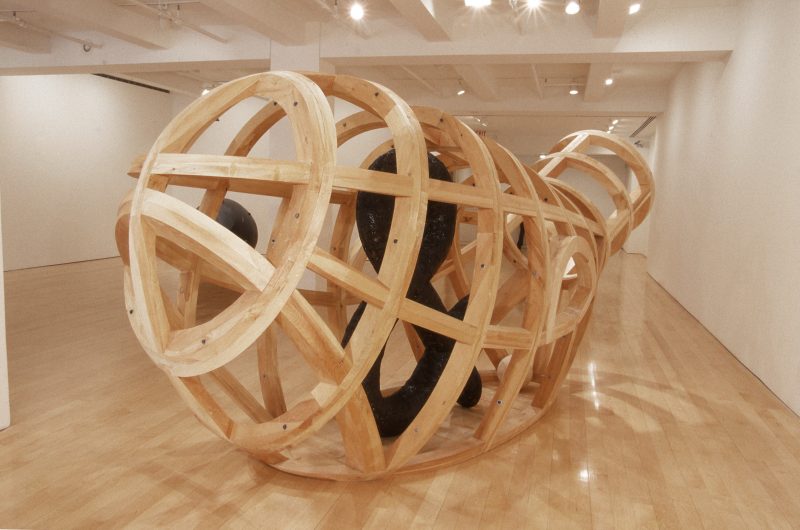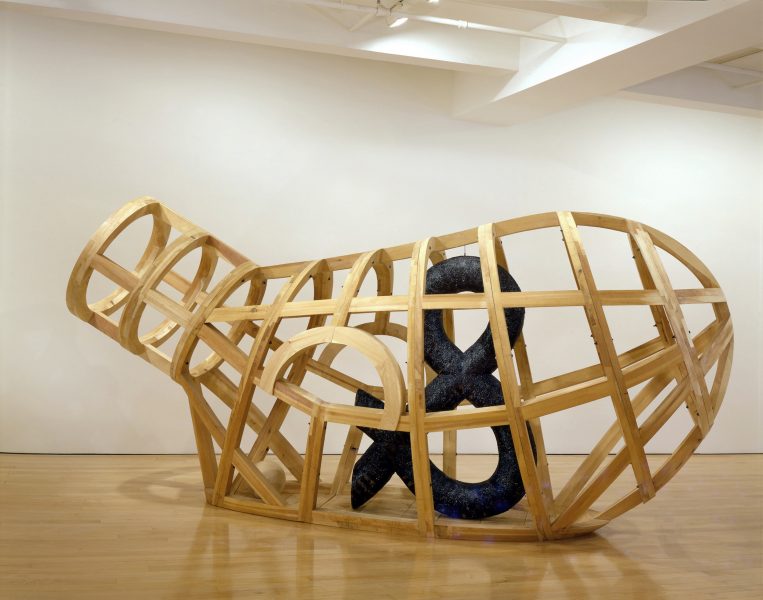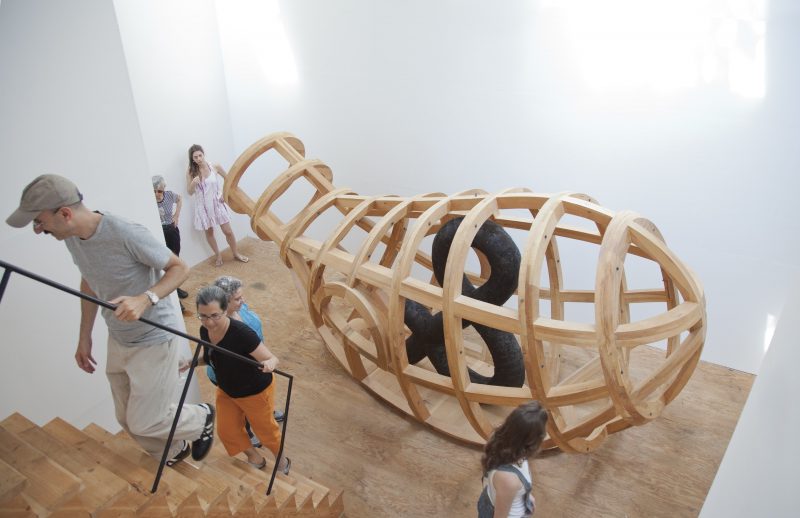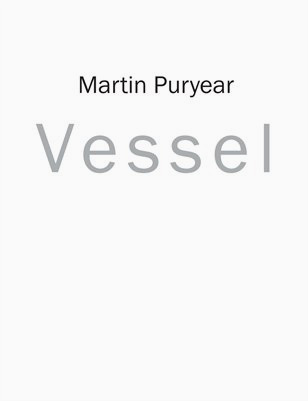


…“At ‘T’ Space [Martin Puryear] is showing “Vessel,” a large wooden piece from 1997-2002. Here the grid is curved to produce a rounded body with an upward pointing neck…”Vessel” crouches on the ground like a plump bird. Inside stands an ampersand. Covered with a heavy coat of tar, this form is so large and emphatic that its meaning is better rendered not as “and” but as “AND.”
…We are drawn back to what is visible and, more than that, palpable: details of carpentry and weaving and metal casting. The curved ribs and struts of Vessel evoke the architecture of boats and old houses in certain varieties of the American vernacular. Yet there is nothing nostalgic about this sculpture. Its forms are crisp and vividly present. Engaging vision, they encourage it to wake up to its speculative power, the energy that propels us from the present of seeing to the future of further understanding, guided by nothing but the sense that the world is not a puzzle to be worked out once and for all but a plenitude that sustains us so long as our attentiveness renews it. To prompt that attentiveness is the purpose of Puryear’s art, or, I should say, one of many purposes, each shading off into the next in a way that reminds me of a line from a poem by Elizabeth Bishop, entitled Over 2,000 Illustrations and a Concordance: everything only connected by ‘and’ and ‘and.’
When I first read this poem, I heard a tone of deprecation in Bishop’s “only,” a suggestion that some adhesive more powerful than “and” would be desirable. Now I think she is saying it’s good that there is only “and” to join things, that more firmly structured connections would be oppressive. This, at any rate, is the reading I favor in the vicinity of Puryear’s Vessel, which contains nothing but “AND” and therefore contains everything.”
-Carter Ratcliff, 2012
… Puryear’s work transcends the conventional boundaries of sculpture, which is traditionally grouped by subtractive and additive forms… ‘Vessel,’ the central piece that Martin Puryear selected for this ‘T’ Space exhibition is neither subtractive nor additive; it is a ‘Thing within a Thing.’
… While discussing Martin Puryear’s ‘Vessel’ with sculptor Mike Metz, we talked about how the ‘thing within the thing’ – the ampersand within the vessel – embodies the idea of connections. The ampersand never exists in isolation; it always joins two ideas – a before and an after. What are those two things in ‘Vessel?’ The message flanking the ampersand is unknown. The answer is absent – even the question is absent. Yet out of absence comes possibility. Anything is possible. ‘Vessel’ invites us to become open to all manner of connections within us and, as with the opening of a book, to see the act of opening as a gift.
-Steven Holl, 2012
BIOGRAPHY
Over the last thirty years, Martin Puryear has created a body of work that defies categorization, creating sculpture and works on paper that examines identity, culture, and history. Puryear’s sculpture combines modernist abstraction with traditions of crafts and woodworking, in shapes informed by the natural world and by ordinary objects and made with materials such as wood, stone, tar, bronze, and wire. As a student, the artist studied ornithology, falconry, and archery, and in the 1960s he volunteered with the Peace Corps in West Africa, where he schooled himself in the region’s indigenous crafts; these are only a few of the influences that have embedded themselves in his work. “I think there are a number of levels at which my work can be dealt with and appreciated,” Puryear has said. “It gives me pleasure to feel there’s a level that doesn’t require knowledge of or immersion in the aesthetic of a given time or place.”
Martin Puryear was born in 1941 in Washington, D.C., and was educated at Catholic University, the Royal Swedish Academy of Arts in Stockholm, and Yale University. His first one-person exhibition opened in 1968, and since that time he has exhibited his work through out the world, with public commissions in Europe, Asia, and the United States. He represented the United States at the 1989 Bienal de São Paulo, where he was awarded the festival’s Grand Prize, and his work was included in the 1992 Documenta. In 2007 The Museum of Modern Art, New York, organized a retrospective exhibition of his work which traveled to the National Gallery of Art, Washington D.C., the San Francisco Museum of Modern Art, and the Modern Art Museum of Fort Worth. In 2015 the Art Institute of Chicago organized an exhibition of his works on paper, the first to explore this aspect of the artist’s oeuvre, which will open at the Morgan Library & Museum and travel to the Art Institute of Chicago and the Smithsonian American Art Museum. Puryear received a Guggenheim Fellowship in 1982, a MacArthur Foundation award in 1989, the Gold Medal in Sculpture by the American Academy of Arts and Letters in 2007, and the National Medal of Arts in 2011.

An exhibition catalog featuring sculptural installations by Martin Puryear at ‘T’Space in Rhinebeck, NY.